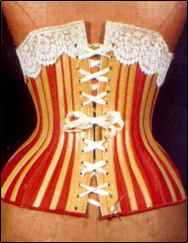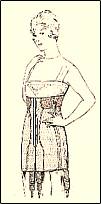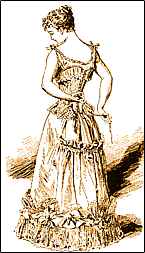Corsets Again?
To corset or not is still the binding question. Nancy Lyons reveals the issues.
Let's admit it - corsetry is sexy and fascinating. Is it the taboo of seeing something usually worn under clothes and close to the skin? Maybe it has to do with all the lacing and the time it takes to put one on or take it off.
Just a few years ago, Jean Paul Gaultier and the 1980's Madonna could be credited for bringing corsetry into full view and accepted in the main stream. Widespread appeal became obvious when recently Catherine Zeta-Jones wore a black corseted gown at the Oscars, and Stella McCartney and Gucci (via Versace) included them in their Spring fashion collections. This style is not restricted to women - one famed maker of corsets wears his night and day, explaining that he enjoys the sculptural presence it produces.
In the new film, Moulin Rouge with Nicole Kidman, wasp-waisted costumes abound. It's not even restricted to celebrities or designers, as chain clothing stores are selling tops that look like softened versions of a corset. The hour-glass figure and the decadence it inspires is definitely back in vogue.
What does it say about women who succumb to that "wasp-waisted" look? Although undergarments have always been worn for warmth and hygiene, the female form has usually been laced in or padded out in some way or another. Since about the early 1870's, with the demise of the crinoline, the corset was the favoured undergarment. The traditional ideal beauty was represented by a tiny waist, the hour glass shape, and later, the exaggerated "s" shape. A young girl's ambition was to marry with a waist size that matched her age.
 |
| Red Satin bound with yellow leather, English, 1883. Back view. (Courtesy of the Victoria & Albert Museum) |
It wasn't until 1900 that doctors, educators, artists and sociologists protested women's fashion for being unhealthy and unnatural.
These reformers said that over time the corset created a deformed female shape, and made natural movement difficult or impossible. Whalebone and metal corsets especially made breathing difficult, curved the spine and weakened the back muscles.
Women suffered in silent agony. At the beginning of "La Belle Époque" between the 1880's and 1905, the Victorian corsets were at their most rigid. They had gotten longer, and were designed to force the bust forward and thrust the hips back, while minimising the hips and stomach.
Nonetheless, the fashion persisted and there were a wide variety of corsets available, apparently to take into account the individual body shapes and styles of dress. To remedy the outdated 19th century corsets, after 1884 a German doctor promoted wearing woolen corsets instead. Somehow wearing wool next to the skin didn't seem the ultimate solution. In 1900, in an attempt to let the skin breathe open mesh corsets appeared on the market. Mainly composed of satin or silk, they were often brightly coloured and decorated with lace. The "Parisian Girdle" was strengthened with whalebone while the lighter and more flexible "Empire" design used steel rods. The "Health Corset", like the woolen one, was held up by straps and didn't need to be so tight.
 |
| Early 1920s corset |
Just after WWI and into the 1920's, a very long corset shaped women into a straighter boyish shape, which made sitting down difficult. However, it was less tight than previous corsets, sat lower under the bosom and had the added advantage of attached garters. It wasn't until the 1930's that the "brassiere" supported and lifted the bust. The soft long-line corset ("girdle") and bra as we now know it, gently held the figure in place. Hidden, elasticized underpanels worked wonders to help restrain a bulging stomach and hips until the 1950's.
In the early years of this century, the haute couture industry seemed in conflict with the needs of the average woman, as illustrated by those who opted out of the mainstream look. As early as 1874, the American Free Dress League was formed and reform clothing was displayed at the 1876 Centennial Exposition in Philadelphia. In England, the Rational Dress Society came about in 1881, and it demanded the abolition of the corset.
The Arts and Crafts and Wiener Werkstätte movements, with their emphasis on craftsmanship and organic ornamentation, also countered the fashion trends of the day. Designers such as Henri van de Velde promoted classic, wearable clothes. He thought that a really beautiful dress would suit any woman. He condemned the corset saying "[it]…does not serve to emphasize a woman's shape or help her move beneath her clothing…" Gustav Klimt, Frank Lloyd Wright and William Morris were similarly in favour of "rational dress", designed to be worn in a complete, harmonious lifestyle. Loud patterns and bright colours should be replaced by muted tones to complement the new interiors. Artists wives like Janet Ashbee and Georgiana Burne-Jones wore these "reform" clothes. They undoubtedly felt spiritually freed from the confines of corsets. Even progressive couturiers such as Fortuny in Italy or Natalia Lamonova in Moscow helped create this new image for women.
 |
| Corsets represented traditional feminine elegance |
It could be argued that the design philosophy depended on an esthetic, rather than, comfort point of view.
Nevertheless, it was not so painfully obvious that many women favoured these loosely-fitted clothes, which ignored traditional elegance in favor of comfort, health and wearability. In this fashion battle, the demure, secure "comfort" clothes wearers became easy targets for caricaturists who just didn't (or wouldn't) understand. Did these women lack feminine charm? Were these clothes worn for practicality? Perhaps they just dressed with a newly emerging confident sense of self.
It's surprising that women would want to wear something that for so long represented the oppression of women. Fetishists aside, women now appear to be saying that they can decide for themselves whether they want to wear something loose or constricting. The artistry of the corset now gives them power. It all seems to have come full circle.
Until 7 June 2002, the Victoria
and Albert Museum in London, UK is featuring an exhibition called
"Curvaceous, Boned, Busty, Bell-shaped and Bustled" which explores
fashion changes (including corsets) through history.
For more information about Victorian corsets, take a look at the following sites:
Dictionary of corsetry related terms and words
Sissi, the "hourglass" Empress of Austra, 1837-98
Lillie Langtry c. 1890
If you have an opinion or comment about this or a related topic, send an email to editor@aboutdecorativestyle.com to have it posted on the website.